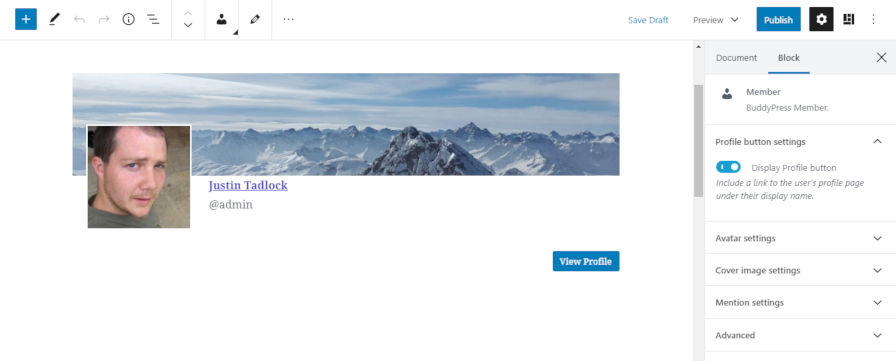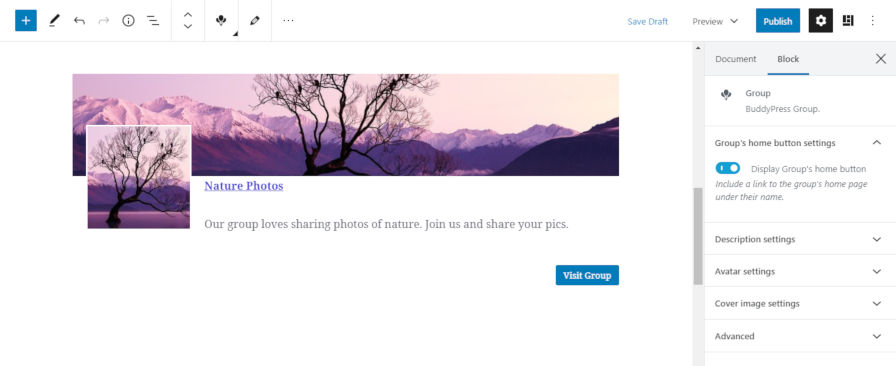BuddyPress 6.0 Beta Introduces Group and Member Blocks
The team behind BuddyPress dropped the first version 6.0 beta release of the plugin yesterday. One of the most important features is the introduction of the new member and group blocks for the WordPress editor. The plugin now requires at least PHP 5.6 and WordPress 4.8 (5.0 to use the new blocks).
“I think it’s exciting times,” said John James Jacoby, lead developer of BuddyPress, on the addition of the new blocks. “Having things as blocks means end-users gain a bit more freedom with where and how they integrate BuddyPress into their existing sites. Right now, BuddyPress blocks are mostly presentational — quick ways to output stuff from the community anywhere blocks are allowed. In a few years, when blocks have matured and are the de-facto way to interact with everything, I can imagine there being a single BuddyPress block that wraps the entire functionality of the community into a single block like its own little web applet.”
BuddyPress 6.0 is scheduled for launch at the end of April. End-users can test the latest version of the plugin via the BP Beta Tester or by directly downloading the beta ZIP file.
Aside from the new blocks, the BP REST API is now complete, which provides developers with a more robust tool to build apps. The user profile photo and cover image fields have also been moved to the Members component of the plugin. This change allows end-users to use the features without activating the BP Extended Profile component.
Introducing the Member and Group Blocks
Version 6.0 of BuddyPress will include only two blocks. However, there are plans to add more over time. The development of blocks takes place in the BP Blocks repository on GitHub.
BuddyPress 6.0 will create a new “BuddyPress” category in the block inserter. This houses the current blocks and will contain those created in the future.
The member block is a simple member profile box that displays the member avatar, cover image, display name, and username. At the bottom of the block, it adds a button to view the member’s profile. Each of the fields can be enabled or disabled via the block settings.

The group block works similarly to the member block. The group avatar, cover image, name, and description are all shown by default. Visibility options are also available via the block settings.

The only trivial gripe I have with the new blocks is how the block settings are handled. Each setting is placed within its own tabbed section. It does not make sense to open or close four tabs to get to a single setting for each. The team may add extra settings under each tab in the future, but it currently feels like unnecessary mouse clicks.
Overall, the team has put together a nice update and the blocks worked without issue.
Future BuddyPress Blocks
Development of BuddyPress blocks began in November 2019. The team garnered 161 votes in a poll on which blocks to build. The initial work started based on that feedback.
“We think working on blocks to highlight a single Group or a single Member is a good starting point,” wrote Mathieu Viet, BuddyPress developer. It made sense to implement simpler blocks for the team’s first foray into block development. It will be a large undertaking that will take many months of development hours to build into the block system.
The team has plans for the future but is looking forward to hearing feedback. “We are very open to ideas into this area,” said Viet. “So the obvious next blocks are transforming our existing widgets into blocks. We are also working on a new Media component, which should include a block to select user-generated media from the block editor.”
Viet said he had at least one “crazy idea” in mind but hasn’t discussed it much with the team yet. “Bring a light version of the block editor into the front end to replace the textarea we are using to post activities,” he said. “Some BP block types like the User Media one would then be available to post richer activity content using a simple property like supports activity.”
Launching the block editor on the front end, even a light version, could be interesting. It may be the future for plugins like BuddyPress that rely on solid front-end posting solutions.
For the near-term future, Viet said the team is looking for contributors to the BP Blocks repository. “We’ll be very happy to include their work into BP Core if we believe our community members would be interested in these blocks,” he said.








